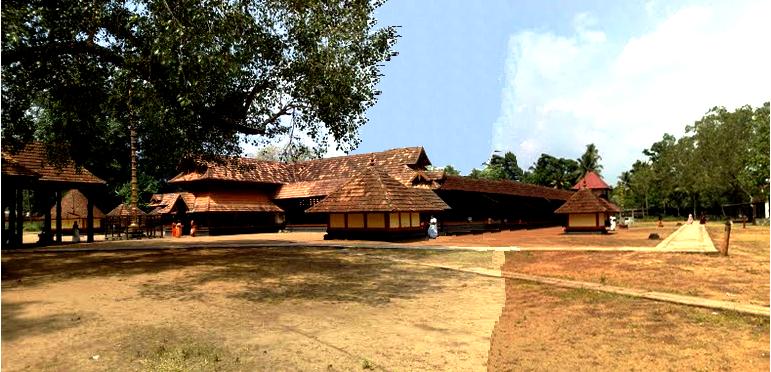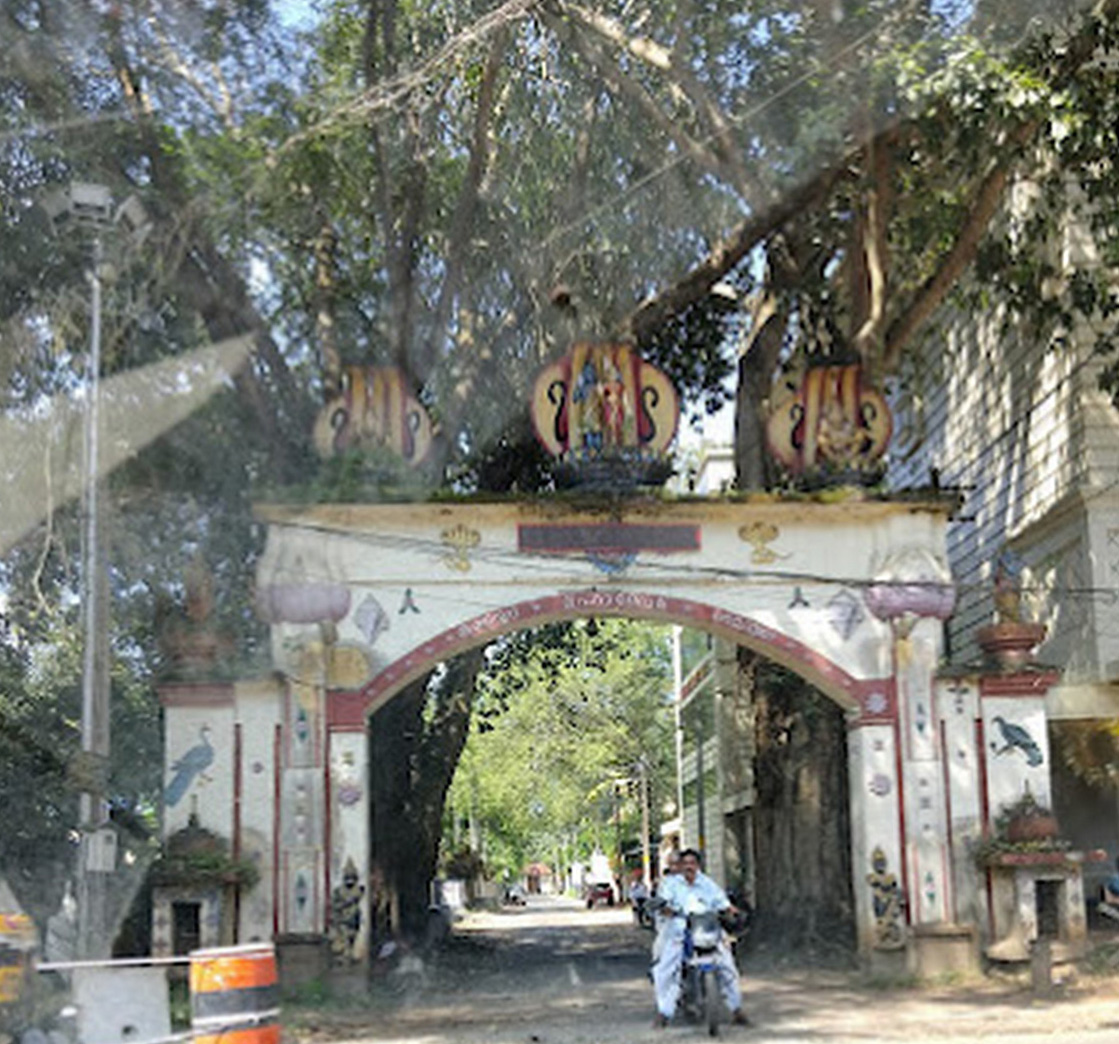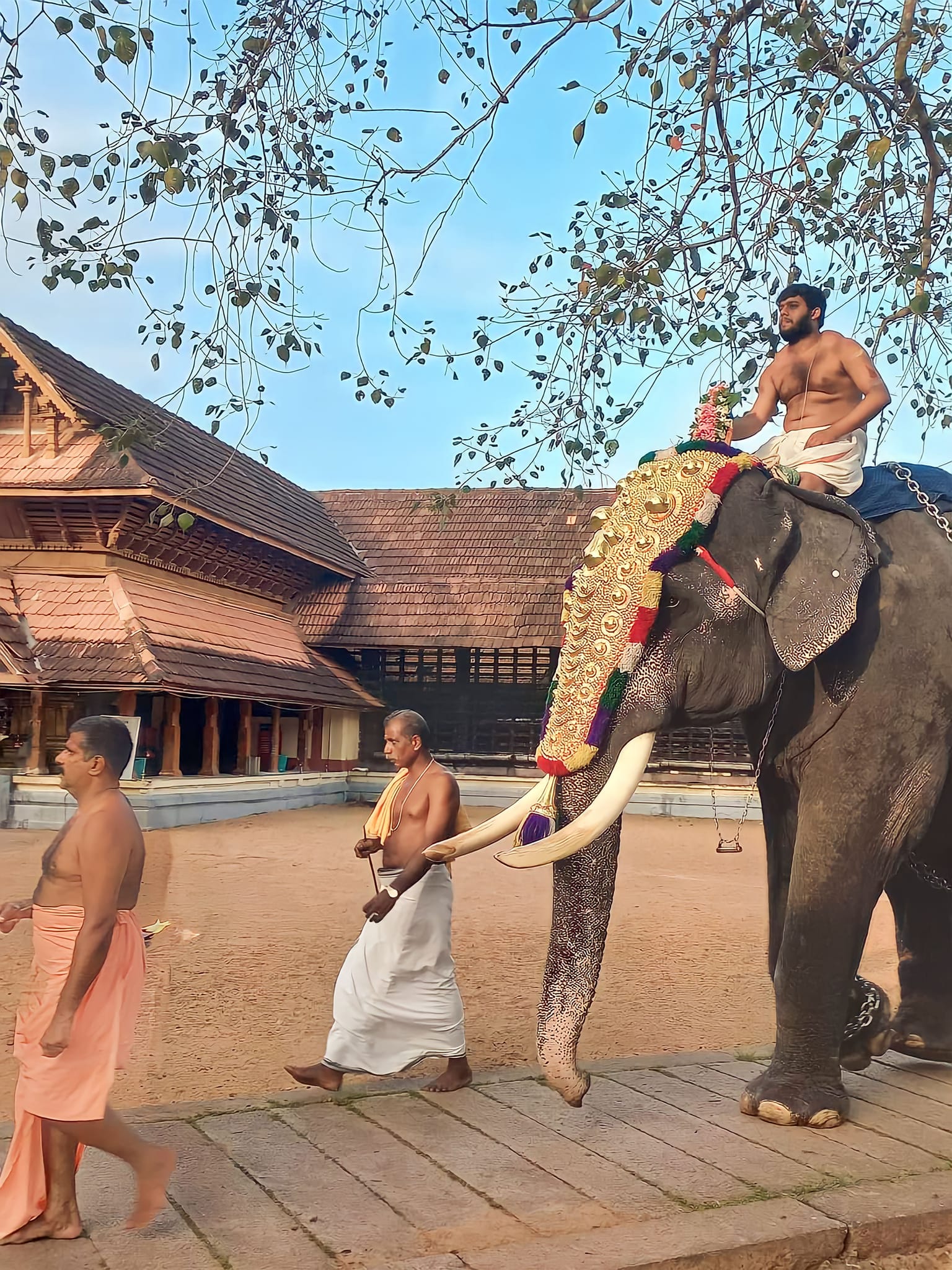Kandiyoor Sree Mahadeva Temple is a historic Shiva temple located in Kandiyoor, close to Mavelikkara, along the banks of the Achankovil River. Historically, Kandiyoor served as the capital of the Odanadu region.

Numerous legends are linked to the temple, which is recognized as one of the 108 significant Shiva temples of ancient Kerala, consecrated by Lord Parashurama himself. According to another tale, Rishi Mrikandu, the father of Rishi Markandeya, discovered an idol of Lord Shiva in the form of Kirathamoorthy while bathing in the Ganges. He received an oracle instructing him to place the idol in a sacred and suitable location.
In his quest for the ideal site, the Rishi traveled to Kerala and ultimately arrived at the banks of Achankovil, where he established the temple in Kandiyoor. The name Kandiyoor is derived from the term Kandathil. The temple is said to be situated at the location where Lord Shiva severed the head of Lord Brahma, according to an alternative legend. The name Kandiyoor is derived from Shiva Sri Kantan. It is also believed that Lord Parasurama restored the temple and conferred tantrik rights upon the Tharananallur family. Kandiyoor and its temple hold significant importance in the historical narrative of Kerala.
The Kandiyoor temple is recognized as the earliest temple documented with an inscription regarding its establishment, dating back to A.D. 823 during the reign of Rajasekhara Varman. The period following the temple's formation was referred to as 'Kandiyoorabdam,' a term that remained prevalent until the advent of the Kollavarsham calendar.
Additionally, it is believed that a Hinayana Buddhist temple existed in proximity to the Kandiyoor temple, which was established and overseen by the Kannankara Panicker family. It is also thought that a displaced statue of Buddha from this temple was later recovered from the adjacent paddy fields and subsequently relocated to the vicinity of the Mavelikkara Sree Krishna Swamy Temple, an area now known as Buddha Junction.
The Kandiyoor inscription (K. E. 393), dated 1218, indicates that the Kandiyoor temple was reconstructed by Rama Kotha Varma of Odanad. The Kalasam ceremony was attended by Unniyachi, the wife of Ravi Kerala Varma, the King of Venad, following discussions among the three parties involved. Kandiyoor was subsequently annexed to Kayamkulam by the Kayamkulam Rajah and later incorporated into Travancore by Marthanda Varma. It is believed that during the conflict between Odanadu and Kayamkulam, the defeated Kayamkulam Raja surrendered his sword at the temple and exited through a rear door, which has remained closed for centuries.
The temple is referenced in the Unnuneeli Sandesam, a work composed around the 14th century. The principal deity worshipped at the temple is Lord Shiva, referred to as Kandiyoorappan, who is regarded as the ruling deity of Kandiyoor. The idol is oriented towards the east. The sanctum sanctorum is designed in a rectangular shape and features two tiers, along with a platform at the front for the convenience of devotees, a characteristic typical of Hoysala architecture. The lower tier is oval, while the upper tier is rectangular. The wall, constructed in the Gajaprishta style and measuring 10 feet (3.0 m) in height, is believed to have been built by Shiva's Bhoothaganas. Additionally, the temple houses stone scriptures that recount various puranic legends. The principal deity, Kandiyoorappan, is regarded as manifesting in the form of Kirathamoorthy.
In the morning, the deity is venerated as Dakshinamoorthy, transitioning to Umamaheshwaran at noon, and Kirathamoorthy in the evening. Worshippers also honor the deity as Panchamukha from the North-West corner of Pradakshina Vazhy, where they observe five Thazikakudams from various Shiva temples, and as Vaikathappan, the ruling deity of Vaikom, during sunset. The temple houses several sub-deities, including Vishnu, Parvatheesan, Nagaraja, Nagayakshi, Gosala Krishnan, Sastha, Sankaran, Sreekandan, Vadakkumnathan, Annapoorneswary, Ganapathy, Subrahmanyan, Moola Ganapathy, and Brahmarakshas. Among these, Sankara, Sreekanda, Vadakkumnadha, Parvatheesa, and Mrityunjaya are considered manifestations of Shiva himself. The temple features six Shivalinga Prathishtas.
കണ്ടിയൂർ മഹാദേവ ക്ഷേത്രം
ആലപ്പുഴ ജില്ലയിൽ മാവേലിക്കരയ്ക്കടുത്ത് അച്ചൻകോവിലാറിന്റെ തെക്കേതീരത്ത് സ്ഥിതിചെയ്യുന്ന കേരളത്തിലെ ഏറ്റവും പുരാതനമായ ശിവക്ഷേത്രമാണ് കണ്ടിയൂർ മഹാദേവക്ഷേത്രം. പുളിമൂട്ടിൽ പാലത്തിന്റെ വടക്കായി മിച്ചൽ ജങ്ഷനും തട്ടാരമ്പലത്തിനും ഇടയിൽ സ്ഥിതിചെയ്യുന്നു. ദക്ഷിണ കാശി എന്നറിയപ്പെടുന്ന ഈ ക്ഷേത്രത്തിലെ പ്രധാന പ്രതിഷ്ഠ കിരാതമൂർത്തി സങ്കല്പത്തിലുള്ള പരമശിവനാണ്. മാർക്കണ്ഡേയ മഹർഷിയുടെ അച്ഛനായ മൃഗണ്ഡുമുനി ഈ ക്ഷേത്രം സ്ഥാപിച്ചതായി പറയപ്പെടുന്നു. ഓടനാട് രാജാവിന്റെ കീഴിൽ പ്രവർത്തിച്ച ഈ ക്ഷേത്രം, രാജാക്കന്മാരുടെ പിന്തുണയാൽ പ്രശസ്തി നേടിയിരുന്നു. ഓടനാട് രാജാവിന്റെ തലസ്ഥാനം കണ്ടിയൂരായിരുന്നു. കണ്ടിയൂർ ആസ്ഥാനമാക്കി ഭരിച്ച കേരളവർമ്മയുടെ സദസ്യനായ ദാമോദരചാക്യാർ എഴുതിയ ശിവവിലാസത്തിൽ ഈ വിവരങ്ങൾ രേഖപ്പെടുത്തിയിട്ടുണ്ട്.
ഓടനാട്ട് രാജാവിനും മാടത്തുംകൂറ് രാജാവിനും ക്ഷേത്രത്തിൽ തുല്യ അധികാരസ്ഥാനമുണ്ടായിരുന്നത്രേ. കേരളത്തിലെ നൂറ്റെട്ട് ശിവക്ഷേത്രങ്ങളിൽ പ്രധാനപ്പെട്ട ഒരു ക്ഷേത്രമാണ് ഇത്, പ്രധാനപ്രതിഷ്ഠ കണ്ടിയൂരപ്പൻ എന്ന പേരിൽ അറിയപ്പെടുന്നു. ഒരു കാലത്ത് ദേവദാസികൾക്ക് ക്ഷേത്രഭരണാധികാരം ഉണ്ടായിരുന്നുവെങ്കിലും, ഇതിന് മുമ്പ് ഇത് ഒരു ബുദ്ധക്ഷേത്രമായിരുന്നു. മാവേലിക്കര അടക്കിവാണ മാവേലിയുടെ നേതൃത്വത്തിൽ, അദ്ദേഹത്തിന്റെയും കുടുംബാംഗങ്ങളുടെയും ആരാധനയ്ക്കായി ബുദ്ധക്ഷേത്രം പണിതിരുന്നു. പിന്നീട്, ഈ ക്ഷേത്രം ശിവക്ഷേത്രമായി മാറി. രാജാവ് ബുദ്ധസന്യാസിയായതിനുശേഷം, 100 വർഷങ്ങൾക്ക് ശേഷം 5-ആം നൂറ്റാണ്ടിൽ ഇത് സംഭവിച്ചതായി സംഘകാല കൃതികളും മണിപ്രവാള കൃതികളും സൂചിപ്പിക്കുന്നു.
കേരളത്തിൽ ഏറ്റവും കൂടുതൽ ഉപദേവതാപ്രതിഷ്ഠകളുള്ള രണ്ടാമത്തെ ക്ഷേത്രമാണിത്, ആദ്യ സ്ഥാനത്ത് തിരുവഞ്ചിക്കുളം ശിവക്ഷേത്രം സ്ഥിതിചെയ്യുന്നു. ആകെ 12 ഉപദേവതകളാണ് ഈ ക്ഷേത്രത്തിൽ പ്രതിഷ്ഠിതമായിരിക്കുന്നത്. കൂടാതെ, ഗണപതി (രണ്ട് പ്രതിഷ്ഠകൾ), സുബ്രഹ്മണ്യൻ, ധർമ്മശാസ്താവ്, മഹാവിഷ്ണു, ശ്രീകൃഷ്ണൻ, അന്നപൂർണ്ണേശ്വരി (പാർവ്വതി), നാഗദൈവങ്ങൾ എന്നിവയുടെ പ്രതിഷ്ഠകളും ഇവിടെ കാണപ്പെടുന്നു. ധനുമാസത്തിലെ തിരുവാതിര ദിനത്തിൽ ആറാട്ടായി പത്തുദിവസത്തെ കൊടിയേറ്റുത്സവവും കുംഭമാസത്തിലെ കറുത്ത ചതുർദ്ദശിദിവസം നടക്കുന്ന ശിവരാത്രിയുമാണ് ഈ ക്ഷേത്രത്തിലെ പ്രധാന ആണ്ടുവിശേഷങ്ങൾ. കൂടാതെ, എല്ലാ മാസവും വരുന്ന മുപ്പെട്ട് തിങ്കളാഴ്ച, പ്രദോഷവ്രതം, തിരുവാതിര നക്ഷത്രം എന്നിവയും പ്രത്യേകമായ ആഘോഷങ്ങളാണ്.
ഈ മഹാക്ഷേത്രം തിരുവിതാംകൂർ ദേവസ്വം ബോർഡിന്റെ കീഴിലാണ്. മാവേലിക്കര കണ്ടിയൂർ മഹാദേവക്ഷേത്രം നിരവധി ഐതിഹ്യങ്ങളുടെ ആധാരത്തിൽ നിലനിൽക്കുന്ന ഒരു മഹാനായ ക്ഷേത്രമാണ്. ഇതിൽ ഉൾപ്പെട്ട ഒരു ഐതിഹ്യം മൃഗണ്ഡു മുനിയെ സംബന്ധിച്ചതാണ്. മാർക്കണ്ഡേയ മഹർഷിയുടെ പിതാവായ മൃഗണ്ഡു മുനിയ്ക്ക് കിരാതമൂർത്തിയുടെ ഒരു തേവാര ബിംബം ലഭിച്ചുവെന്നാണ് പറയുന്നത്. അദ്ദേഹം ആ ബിംബം ഭൂമിയിലെ ഏറ്റവും ഉത്തമമായ സ്ഥലത്ത് സ്ഥാപിച്ച് നിത്യ പൂജനം നടത്താൻ ആഗ്രഹിച്ചിരുന്നു. അവസാനം, അച്ചൻകോവിലാറിന്റെ തീരത്ത് ഒരു മനോഹരമായ സ്ഥലത്തെ കണ്ടപ്പോൾ, അദ്ദേഹം ശിവലിംഗം അവിടെ സ്ഥാപിച്ചുവെന്നാണ് ഐതിഹ്യം.
അദ്ദേഹം കണ്ടതിന്റെ സൌന്ദര്യത്തെ അടിസ്ഥാനമാക്കി, ഈ സ്ഥലത്തിന്റെ പേര് ലോപിച്ച് കണ്ടിയൂർ എന്നാണു വിശ്വസിക്കുന്നത്. രണ്ടാമത്തെ ഐതിഹ്യം ബ്രഹ്മദേവനെക്കുറിച്ചാണ്. കള്ളം പറഞ്ഞ് മഹാവിഷ്ണുവിനെതിരെ മത്സരത്തിൽ വിജയിക്കാൻ ശ്രമിച്ച ബ്രഹ്മദേവന്റെ ഒരു തല ശിവപെരുമാൾ തന്റെ ചെറുവിരലിൽ മുറിച്ചാണ് ശ്രീകണ്ഠനായി മാറിയത്. ഈ സംഭവം അച്ചൻകോവിലാറിന്റെ തീരത്ത് നടന്നുവെന്നാണ് പറയുന്നത്. അതിനുശേഷം ശ്രീകണ്ഠനെ അടിസ്ഥാനമാക്കി ഈ സ്ഥലത്തിന്റെ പേര് ശ്രീകണ്ഠിയൂരും പിന്നീട് കണ്ടിയൂർ എന്നായി മാറിയെന്നു മറ്റൊരു ഐതിഹ്യം പറയുന്നു. പിന്നീട്, അവിടെ വിഷ്ണുവിന്റെ ആറാം അവതാരമായ പരശുരാമൻ പ്രതിഷ്ഠ നടത്തിയെന്നു പറയപ്പെടുന്നു.
ക്ഷേത്രം ചേര രാജാക്കന്മാരുടെ കാലത്ത് നിർമ്മിതമായതായി ചരിത്ര രേഖകൾ സൂചിപ്പിക്കുന്നു. മുമ്പ് ബുദ്ധമതത്തിന്റെ ആരാധനാകേന്ദ്രമായിരുന്ന കണ്ടിയൂർ ക്ഷേത്രം, മാവേലിയുടെ നേതൃത്വത്തിൽ അദ്ദേഹത്തിന്റെയും കുടുംബാംഗങ്ങളുടെയും ആരാധനയ്ക്കായി നിർമ്മിക്കപ്പെട്ടിരുന്നു. പിന്നീട്, ഈ ബുദ്ധക്ഷേത്രം ശിവക്ഷേത്രമായി മാറി. രാജാവ് ബുദ്ധ സന്യാസിയായതിനുശേഷം, 15-ാം നൂറ്റാണ്ടിൽ, 100 വർഷങ്ങൾക്ക് ശേഷം, ഈ മാറ്റം സംഭവിച്ചതായി സംഘകാല കൃതികളും മണിപ്രവാള കൃതികളും സൂചിപ്പിക്കുന്നു. ക്രി.വ. 823-ൽ സ്ഥാപിതമായ ക്ഷേത്രം, ശിലാസാസനങ്ങളിൽ നിന്നുള്ള വിവരങ്ങൾ പ്രകാരം, ആ കാലഘട്ടത്തിൽ കണ്ടിയൂരബ്ദം എന്ന പുതിയ ഗണനാക്രമം നിലവിൽ വന്നതായി രേഖപ്പെടുത്തിയിട്ടുണ്ട്.
ഈ ക്ഷേത്രാങ്കണത്തിൽ പ്രദക്ഷിണ വഴിയിൽ സ്ഥാപിച്ചിരുന്ന ശിലാശാസനം, പിന്നീട് അക്ഷരങ്ങൾ കൂടുതൽ മാഞ്ഞുപോകാതിരിക്കുവാനായി ക്ഷേത്ര ചുമരിൽ ഉറപ്പിച്ചിരിക്കുന്നതായി നമുക്ക് കാണാം. രണ്ടാം ചേരസാമ്രാജ്യത്തിലെ ചക്രവർത്തിയായ രാജശേഖര വർമ്മൻ ഇവിടെ ക്ഷേത്രം പുനരുദ്ധീകരിച്ചുവെന്നാണ് ചരിത്രത്തിൽ രേഖപ്പെടുത്തിയിരിക്കുന്നത്. 1218-ൽ കണ്ടിയൂർ ശാസനത്തിൽ രവികേളവർമ്മയെയും (1215-1240) അദ്ദേഹത്തിന്റെ ഭാര്യ ഉണ്ണിയച്ചിയെയും പരാമർശിക്കുന്നതിനു പുറമെ, ഓടനാട്ടുരാജാവായ കോതവർമ്മ വേണാട്ടുരാജാവിന്റെ നിർദ്ദേശപ്രകാരം കണ്ടിയൂർ ക്ഷേത്രം പുതുക്കിപ്പണിയുന്നതായും വിവരിക്കുന്നു. കേരളത്തിലെ പുകൾപെറ്റ ക്ഷേത്രങ്ങളുടെ പട്ടികയിൽ ഉൾപ്പെടുന്ന ഈ ക്ഷേത്രം, ക്ഷേത്ര മതിലകത്തിന്റെയും, ക്ഷേത്ര സമുച്ചയത്തിന്റെയും വലിപ്പത്തിൽ ശ്രദ്ധേയമാണ്. മാവേലിക്കര നഗരത്തിലെ ഹരിപ്പാട് റോഡിൽ, ഏഴര ഏക്കർ വിസ്താരമുള്ള മതിൽക്കകത്താണ് ഈ മഹാക്ഷേത്രം സ്ഥിതിചെയ്യുന്നത്.
കേരളത്തിൽ ഏറ്റവും കൂടുതൽ ഉപദേവതാ പ്രതിഷ്ഠാദേവാലങ്ങൾ ഉള്ള മഹാക്ഷേത്രങ്ങളിൽ ഒന്നായാണ് ഇത് അറിയപ്പെടുന്നത്. ക്ഷേത്രപ്പുരയുടെ മതിൽ ഉയരത്തിൽ വളരെ ശ്രദ്ധേയമാണ്. നാലു മതിലുകൾക്കും നാല് ഗോപുരങ്ങൾ ഉണ്ട്; കിഴക്കേ ഗോപുരവാതിലിൽ ഗജേന്ദ്ര മോക്ഷം, കൃഷ്ണാവതാരം തുടങ്ങിയ ദാരുശില്പങ്ങൾ മനോഹരമായി കൊത്തിവച്ചിട്ടുണ്ട്. ഇരുനിലയിൽ നിർമ്മിതമായ മഹാസൗധമാണ് ഈ ശ്രീകോവിൽ. രണ്ട് നിലകളിൽ പണിതിരിക്കുന്ന ഈ ക്ഷേത്രത്തിന്റെ താഴത്തെ നില വർത്തുളാകൃതിയിലും, മുകളിലത്തേത് ചതുരാകൃതിയിലും രൂപകൽപ്പന ചെയ്തിരിക്കുന്നു. കിഴക്കോട്ട് ദർശനം നൽകുന്ന കിരാതമൂർത്തിയായി ശ്രീപരമേശ്വരൻ ഇവിടെ മഹാശിവലിംഗ രൂപത്തിൽ പ്രത്യക്ഷപ്പെടുന്നു. ഈ ശ്രീകോവിലിന്റെ പഴക്കം വ്യക്തമാക്കിയിട്ടില്ല.
ക്ഷേത്രത്തിന്റെ ഭിത്തികൾ കരിങ്കല്ലും മണ്ണും ചേർത്ത് നിർമ്മിച്ചിരിക്കുന്നു. ക്ഷേത്രത്തിലെ വിവിധ ഭാഗങ്ങളിൽ ശ്രീകോവിലിന്റെ കരിങ്കൽ അടിത്തറയിലും വട്ടെഴുത്തിൽ നിരവധി ശാസനങ്ങൾ കാണാൻ സാധിക്കും. നാലമ്പലത്തിൻ ചുറ്റുപാടിൽ 11 ഉപദേവതാ പ്രതിഷ്ഠകൾ കാണപ്പെടുന്നു. ഇവ വിവിധ കാലഘട്ടങ്ങളിൽ സ്ഥാപിച്ചവയാണ്. അഞ്ചു പ്രതിഷ്ഠകൾ മറ്റ് ശിവക്ഷേത്രങ്ങളിൽ നിന്നുള്ള കുടിയിരിപ്പുകളാണ്. ശങ്കരൻ, ശ്രീകണ്ഠൻ, മൃത്യുഞ്ജയൻ, പാർവ്വതീശൻ, വടക്കുന്നാഥൻ എന്നിവയാണ് അവ. ഇവയ്ക്കു പുറമെ വിഷ്ണു, നാഗദൈവങ്ങൾ, ഗോശാലകൃഷ്ണൻ, ശാസ്താവ്, അന്നപൂർണേശ്വരി (പാർവ്വതി), സുബ്രഹ്മണ്യൻ, ഗണപതി, ബ്രഹ്മരക്ഷസ്സ് തുടങ്ങിയ മറ്റ് ചെറിയ ഉപപ്രതിഷ്ഠകളും ഉണ്ട്.
Address:
Kandiyoor, Mavelikara, Kerala 690103



